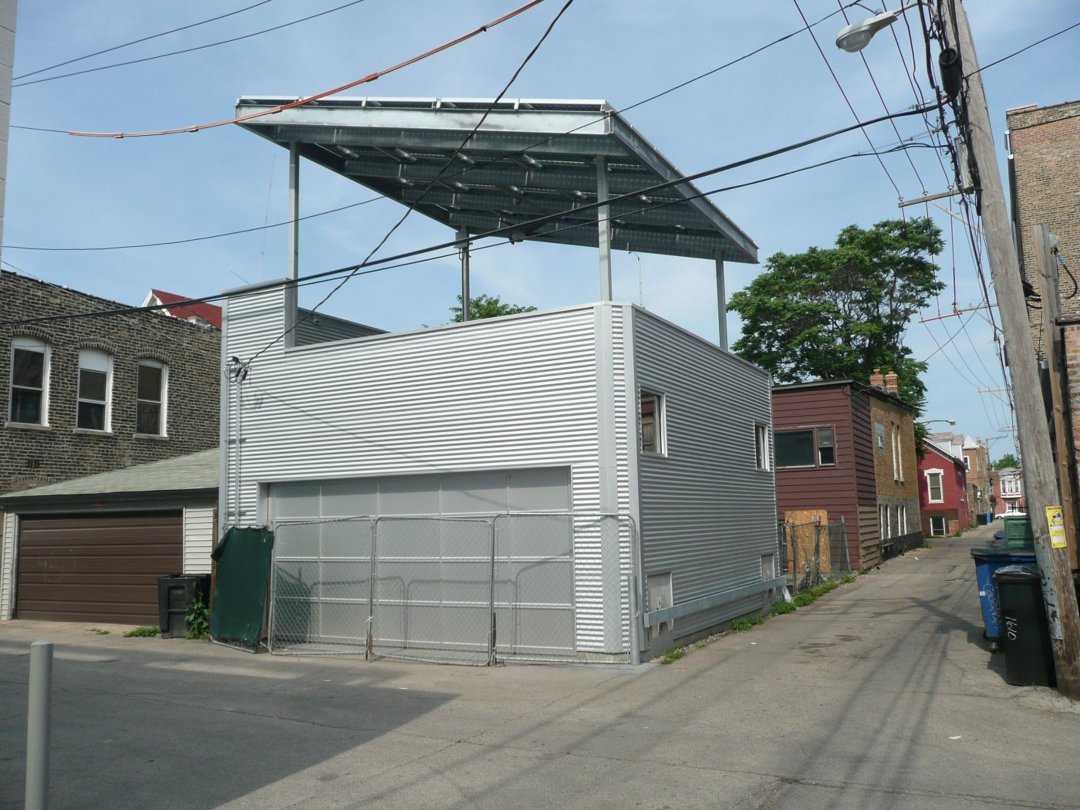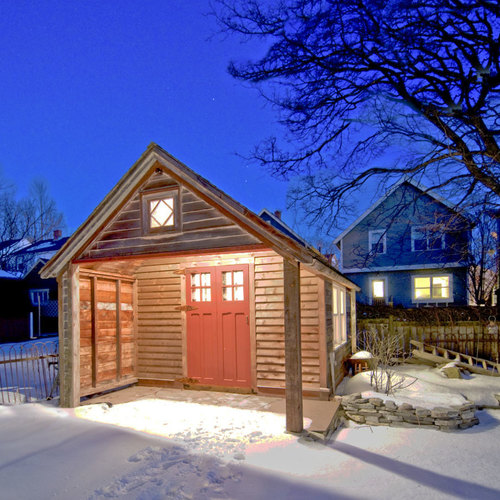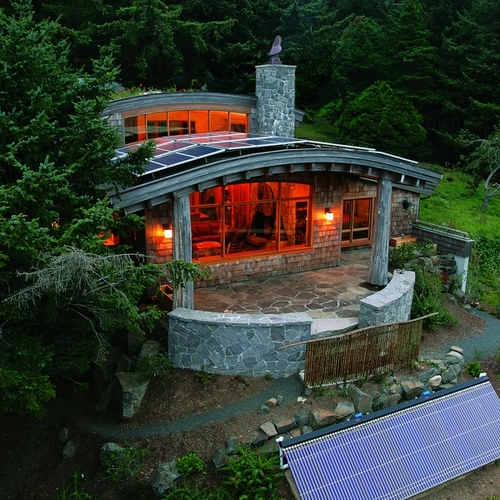
Image Credit: Thomas McGrath
Image Credit: Thomas McGrath Recycled aluminum. The skin of the garage door includes 37% recycled aluminum. This door faces the alley; on the other side of the garage, a narrower overhead door faces the yard.
Image Credit: Thomas McGrath Blue oat grass and Ruby Star purple coneflowers are native plants that thrive in full sun exposure. Once established, they will be able to survive without regular watering.
Image Credit: Thomas McGrath Outdoor fan. This overhead fan provides a cooling breeze for those enjoying the rooftop deck on a summer afternoon.
Image Credit: Thomas McGrath Translucent solar panels. The canopy's PV cells are encapsulated between two layers of glass. The gaps between the dark-colored PV cells allow filtered sunlight to pass through the canopy.
Image Credit: Thomas McGrath
Fly-ash concrete and a PV array reduce this garage’s environmental impact
By Thomas McGrath
With help from a photovoltaic (PV) array, this garage in Chicago’s Bucktown neighborhood produces far more energy than it consumes. Made from durable green materials, the garage is providing power to workers undertaking a gut rehab of the 1890s single-family home at the same address.
The rehab work will consist of “unwrapping the building” — replacing all the components that reduce its energy performance — and wrapping the building back up with (mostly) salvaged materials. While the retrofit work is underway, the garage will be used as a shop for the salvage operation.
Doing double duty
The 24 ft. by 24. ft. garage was designed as an entertainment space that doubles as a place to park the car. Among the garage’s amenities: a mini-kitchen with an under-counter refrigerator.
The garage has two overhead doors: an 18-ft.-wide door leading to the adjacent alley and an 8-ft.-wide glass door on the opposite side that opens to the yard, a shaded play and gathering space for summer cookouts.
The garage will include a rooftop deck that will be attached to the house with a bridge. The light-colored Trex decking will keep the garage cool and reflect sunlight onto the underside of the PV canopy.
The 550-square-foot canopy was inspired by the palm palapas of Mexico. My Chicago “palapa” is expected to produce an average of 700 kWh of electricity per month.
The solar array
The 7.6-kW PV array consists of forty 190-watt Sanyo bifacial PV modules. Under the right conditions, reflected light hitting the underside of the PV modules may boost the array’s output by 5% to 15% — perhaps increasing the peak output to 8.7 kW. During sunny summer months, the array generates over 900 kWh per month.
Unfortunately, net-metering regulations in Illinois are not particularly favorable to owners of PV systems. While utilities in Ontario and Gainesville, Florida, offer to buy electricity from PV producers at 3 to 5 times the retail rate, no such “feed-in” tariff is available in Illinois. While I will be credited for any excess electricity production, the credits will disappear if they aren’t used up within 12 months. (More information about feed-in tariffs is available at the Alliance for Renewable Energy.)
Fly-ash concrete: win, win, win
According to the Environmental Protection Agency, portland cement is the third largest contributor to greenhouse gasses in the U.S.and is responsible for 7% of the world’s production of greenhouse gasses.
Replacing up to 50% of the portland cement in concrete with fly-ash and slag — waste byproducts produced by coal-fired power plants — reduces the carbon emissions attributable to concrete by half. I call this “win #1.” Diverting the coal-plant waste from a landfill is win #2. Lastly, because fly-ash is composed of smaller molecules than portland cement, the resulting concrete is denser and stronger — win #3.
Urban landscaping with native plants
Since we want to embrace the urban nature of the city alley rather than turn our back on it, the area around the garage was planted with native Illinois grasses and plants.
The garage incorporates a variety of green materials, including FSC-certified lumber, LED and CFL lights, galvanized steel siding, a garage door made from aluminum with a 37% recycled content, and a rainwater collection system. These durable materials will lower the building’s environmental impact over its expected 100+ year lifespan.
Weekly Newsletter
Get building science and energy efficiency advice, plus special offers, in your inbox.
Lessons Learned
Fly-ash concrete: Don’t wimp out
Many builders avoid fly-ash concrete because it takes a little longer to set up. But if you are building a structure with a planned durability of 100+ years, how important is it to save a couple of weeks up front?
On our initial concrete pour (the stemwalls), we only used 35% fly-ash, the industry standard. Later, when we learned more about the multiple benefits of fly-ash, we bumped that percentage up to 50% for the slab.
Install the solar array first
Because of a deadline on a state-funded grant, we ended up building the garage before rehabbing the house. Because of this decision, all the on-site energy needed to construct the home — to run our power tools, light the space, and heat the space during construction – comes from a renewable source.
Instead of the PV array being the last thing you throw up after the project is complete, consider putting it up first. Using PV-generated electricity during construction will lower the embodied energy of the home even before its occupied. All projects may not allow this step, but it’s worth doing if possible.
— Thomas McGrath's construction blog is at elementalbuilding.com.
General Specs and Team
| Location: | Chicago, IL |
|---|---|
| Living Space: | 576 |
| Cost: | 208 |
Architect: Gerhard Zinserling Builder: Act Development Inc. Fly-ash concrete: Ozinga Solar electric system: Habi-tek
Energy
- LED and CFL lights
Water Efficiency
- Rainwater collection system
Green Materials and Resource Efficiency
- Fly-ash concrete
- FSC-certified lumber
Alternate Energy Utilization
- 7.6-kW PV array, Fronius 7.5 kW inverter











5 Comments
Fly -ash
Great use of materials on your foundation and mostly amazed about the amount of research you have done to support this construction. With all that goes into building a home these days its a breath of fresh air that someone has spent the time to craft a plan for a better --greener--house. My concern for fly-ash only comes from how difficult it will be to get when the coal-fired plants get de-commissioned:
This little point in fact from this web site (http://www.toolbase.org/Technology-Inventory/Foundations/fly-ash-concrete)
"The Clean Air Act of 1990 requires power plants to cut nitric oxide emissions. To do so, plants restrict oxygen, resulting in high-carbon fly ash, which must be reprocessed for cement production. Thus, fly ash could be less available or more costly in the future."
How green is this really?
Although I commend the use of solar panels and re-usable materials on this project, we also need to understand that this 2-flat structure once house two entire families. This project is adding another story plus eliminating one unit thus at least tripling the amount of square footage utilized by a family. This action is also lowering urban density. So is this really "greening" this building, or is it "ungreening" it??
There is also construction of the garage, a structure designed to house cars in a neighborhood designed for walking and with numerous public transportation options available (or ostensibly provide even more living space). Did this large concrete and steel garage really "green" the space? Or perhaps an open yard with a garden would have been greener.
I would also comment on the mention of the "bridge" from the house to the garage. These structures, known as "connectors" have become highly controversial and are under consideration to be outlawed in residential neighborhoods by Chicago zoning code. The reason is that their height often blocks the sunlight coming into the neighbors lot. They also tower over the neighbors back yards, shading out gardens, removing visibility to the sky and other sight lines.
The same problem will exist with the canopy that houses the solar panels. This type of towering structure is very unfriendly to the neighbors. (A typical Chicago lot is 25' wide). This solar canopy could have been placed on the flat roof of the now 3-story building where it would have been out of sight.
So, in summary, I think a legitimate question to ask is how green is this project really? And how much of it is just more consumption of resources, wrapped in positive spin?
Response to Urban Citizen
I think your points are well made and I agree with your basic argument.
Some factual corrections and other considerations:
- The building is located in a multi-use zoned neighborhood with several large 4-5 story buildings in the immediate vicinity. These buildings provide much more shade to the neighbors than the garage solar canopy I built.
- There is a 4 story building south of the project which- even with the additional floor we added- prevented locating the 7.6 KW array on the roof of the house.
- The PV canopy on the garage shades only the neighbor's garage.
- As part of the permit process, zoning approval required the notification of the alderman and the neighbors, and there were no objections to our proposal. In fact, many neighbors stop on a regular basis and comment on how 'cool' they think the project is.
-I had not thought of the bridge as being an issue, nor heard of the problem in general (Again this is a point well made by you). We will be building the bridge deck and railings with open web metal, so such shading hopefully will be minimized. For what it is worth, my neighbor to the north (who would be affected by our bridge) cut down a 30 ft tree in his back yard last fall because he was tired of raking the leaves. He also placed a new concrete sidewalk through the same back yard. So I know he is not concerned about what will or will not grow there.
-Your points about urban density are important, but stating that the square footage tripled is an exaggeration. There were 2 small 2-bedroom apartments on the property before we started the renovation. Had they remained, there would likely have been 1 or 2 persons per apartment. In fact the family who I bought from and who owned the property since the early 70s had treated the building as their single residence occupying both apartments. Yes its true we added another floor, but that's an increase of 50%, not 300%. Moreover one family lived on this standard Chicago 25ft x 125ft lot for the past 25 years, and hopefully one family will live on the same lot for the next 25 years.
-The 600 sf of space between the house and the garage had been a slab of concrete where people worked on their cars. We are taking that out, re-using the concrete for patio and wall material and turning that space into garden.
Lastly, part of the reason I needed to make a bigger house was the price point for which I purchased the existing structure/land. That's not green, but it's a reality. In some ways this house is like Whole Foods or a Toyota Prius- a step in the right direction, but not the ultimate answer (What we really need is local food production, public transportation, and retrofitting of existing structures). Thanks for your comments. I too appreciate the urban environment- its why I chose to live and build here. Personally, I don't even own a car. That said though if every house on my block built a PV canopy exactly like mine- one that covered an existing garage, and provided enough electricity to cover the annual use of the house- I think that would be awesome.
So much information packed
So much information packed into ten minutes of perusing. Great project and great discussion.
Interesting
Thank you for sharing this project. It's great to see urban rehabs incorporate solar like this. The deck will be a fun place for summer dining.
Log in or create an account to post a comment.
Sign up Log in